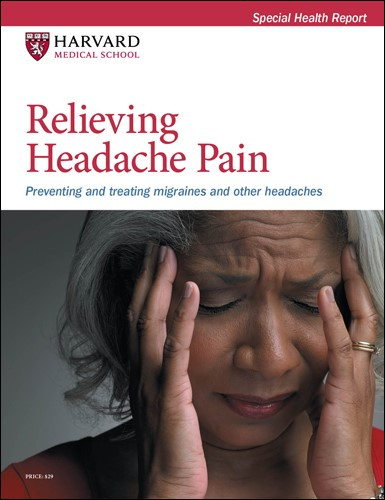Not just another headache
When your head is throbbing, certain signs can point to trouble. Here's when to seek help.
- Reviewed by Toni Golen, MD, Editor in Chief, Harvard Women's Health Watch; Editorial Advisory Board Member, Harvard Health Publishing; Contributor

Mia delivered a baby and went home feeling fine. Within a week, however, she developed a persistent headache. She brushed it off for two or three days, reasoning that she was sleep deprived. But her head hurt even worse when she had to cough or bear down, and then her vision went wonky, seeming blurry.
Fortunately, Mia made a prompt doctor's appointment. The culprit? A clot in one of the veins of her brain, which increased pressure in her skull and triggered her headache.
Mia's situation is unusual, since only a tiny fraction of headaches indicates something is seriously amiss, Harvard experts say. Far more common are the harmless headaches that happen to people every day. About 4% of American adults report "being bothered a lot" by headaches in the past three months — with women three times as likely to report the problem as men, according to the CDC.
Some people power through headaches, even severe ones, because they're convinced they shouldn't complain about such a common issue. But certain sensations tend to tip people off when they're not having a run-of-the-mill headache.
"In general, people know their headaches really well," says Dr. Paul Rizzoli, division chief of the Graham Headache Center at Harvard-affiliated Brigham and Women's Faulkner Hospital. "With that in mind, any changes to your typical pattern of headaches could be worth paying attention to."
Red flags
If headaches are happening more frequently or getting progressively more painful, it's time to see a doctor. The following signs also increase the risk that a headache stems from a worrisome underlying cause.
You also have other symptoms. Watch for fatigue, fever, night sweats, or double vision. "These types of symptoms can happen if you have an infection or increased pressure in the brain," says Dr. Linda Wendell, chief of neurology at Harvard-affiliated Mount Auburn Hospital.
You're over 50 and your headaches have changed. Maybe you never had them before, and now you get them regularly. Or they're happening in a different area of your head. "As we get older, there's a higher probability that new headaches are associated with other problems," Dr. Wendell says.
Your headaches get worse when you lie down, after exercise or sex, or when you cough. These activities temporarily alter the pressure inside your brain, leading to pain. While this might be due to various causes, doctors will need to rule out a tumor or other reasons for increased pressure inside the skull, Dr. Wendell says.
Your pain doesn't respond to simple remedies. Most headaches recede if you take a nonprescription pain reliever such as acetaminophen (Tylenol), ibuprofen (Advil), or naproxen (Aleve), or if you drink some water and lie down for a nap. "In general, you should get some relief from over-the-counter pain medication; if not, contact your doctor for advice," Dr. Wendell says.
Emergency signs
Some distinct symptoms can't wait for a doctor's appointment. If any of these occurs, call 911 or head to an emergency department immediately:
A "thunderclap" headache. So named because the pain arrives suddenly and violently, ascending in seconds, this can sometimes occur with bleeding in the brain or a variety of other serious causes. "A thunderclap headache is sometimes referred to as the worst of your life," Dr. Wendell says.
Headache with fever and a stiff neck. This combination often signals meningitis, a potentially life-threatening inflammation of the membranes covering the brain and spinal cord. "This isn't the same as coming home from work with tight muscles on one side of the neck and a tension headache," Dr. Rizzoli says. "It's dramatic. You'll feel terrible."
Headache with neurological symptoms. Vision changes, difficulty speaking, or numbness and weakness may suggest a stroke, as does confusion, sleepiness, or other signs of altered mental status. "Regardless of whether or not you have a headache, any new neurological symptoms — especially when they affect one side of the body — constitute an emergency," Dr. Wendell says.
Sudden headache with vomiting. While this duo often occurs during a migraine, in some cases it can also indicate a much more serious condition, such as a ruptured aneurysm or other reason for bleeding in the brain.
Headache after a blow to the head, such as from a fall, auto accident, or sports injury. "Most people know to get evaluated if they hit their head and then get a headache," Dr. Wendell says.
Image: © Kawee Srital-on/Getty Images
About the Author

Maureen Salamon, Executive Editor, Harvard Women's Health Watch
About the Reviewer

Toni Golen, MD, Editor in Chief, Harvard Women's Health Watch; Editorial Advisory Board Member, Harvard Health Publishing; Contributor
Disclaimer:
As a service to our readers, Harvard Health Publishing provides access to our library of archived content. Please note the date of last review or update on all articles.
No content on this site, regardless of date, should ever be used as a substitute for direct medical advice from your doctor or other qualified clinician.
















